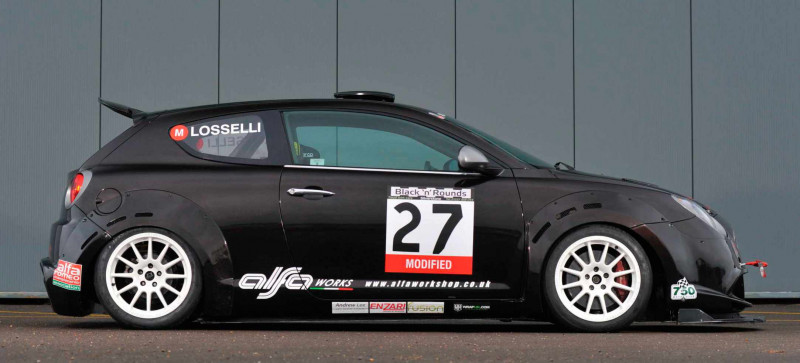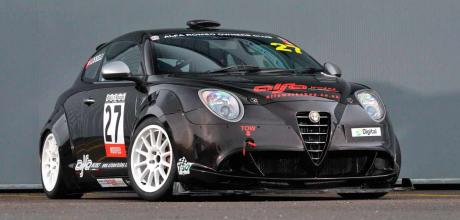Alfa-Romeo Mito Racer AlfaWorks’ amazing 404hp track tearaway
With 404hp of power going through the front wheels, this AlfaWorks MiTo is a ferocious newcomer in Alfa Romeo racing. We meet its creator and try to tame it on track. Story by Chris Rees. Photography by Michael Ward.
It’s been lighting up Britain’s circuits in the Alfa Romeo Championship. Now I’m staring down the long straight at an airfield, about to experience what 404hp of power feels like through the front wheels. My sense of anticipation about driving this new AlfaWorks MiTo racer is making itself felt through some very sweaty palms.

This mighty MiTo is now well into its racing career but it was actually originally bought by Jamie Porter of the Alfa Workshop as a development hack. The project had been begun about seven years ago by Dave Thomas, who started out with a crashed MiTo 1.4 TB Quadrifoglio Verde. When its owner retired, Jamie snapped the car up.
“I bought it because I wanted what they call a muletto in Italy – a mule – to test out the 2.0-litre engine we were developing for our Alfa 4C 410. Basically if we bent the MiTo during testing, it wouldn’t matter as much as bending the 4C.” If that AlfaWorks 4C sounds familiar, that’ll be because Auto Italia featured it earlier this year, when the spectacular 4C 410 was our cover car in April 2021. “As its name suggests, the 4C has 410hp,” says Jamie, “but the MiTo has a little less.” We’ll get to that in a moment.

The MiTo was chosen by its original owner as a great basis for a racer as a salvaged car with rear three-quarter crash damage. As bought by Jamie, it already had its bespoke cage fitted. The car’s spectacular look – and sophisticated aerodynamics – were created at the Alfa Workshop. An aftermarket Magneti Marelli bodykit has been much modified. For instance, the front wheelarch has been moved out to fit a cooling vent (it sits flush as standard), while the big rear arches have cooling grilles too. The front spoiler has a huge splitter added, which is hinged so that the car can physically get on and off Jamie’s trailer. The car has a completely flat undertray made of plywood that’s designed to be a consumable, as Jamie comments: “We’ve already got through two floors – it sits just 45mm off the deck.”
One advantage of the MiTo’s simple beam rear axle set-up is that there’s plenty of space to fit an enlarged rear diffuser – and it is enormous. It’s composed of two parts: an aftermarket upper section and aluminium lower part. As for the tailgate spoiler, that’s another Magneti Marelli MiTo item and is adjustable for angle via a riveted base.
The roof vent provides all of the ventilation for the cabin, since the front firewall allows no air in. While the side and rear windows have been replaced with Plexiglas, the driver’s window retains the original glass because it’s frameless. Open the vented bonnet and behind the front grille you’ll see a strengthening bar. This has Alfa heritage as Jamie pinched it off his Stelvio when he fitted a tow bar to his 4x4. It just happened to be a perfect fit! Lurking under the bonnet is the party piece of the car: Alfa’s 1750 TB engine that’s been expanded to 2.0 litres by the Alfa Workshop. It’s basically a preproduction version of the engine that AlfaWorks offers in its 4C. The 1742cc unit has been upped to 1995cc courtesy of a longer stroke. The internal changes are wide-ranging, including Omega CNC pistons and rings, Arrow con rods and uprated crank and thrust bearings. The cylinder head is gas-flowed to increase flow rate, while the camshafts are uprated but still quite mild, as the main aim of the engine set-up is to get as much air as possible into the turbocharger. That’s a twin-scroll Borg Warner turbo, attached to a bespoke tubular exhaust manifold that’s much freer flowing. Naturally the hosing and piping is all uprated, too, while the MiTo boasts twin radiators.
One other arena of major development is the engine management system, undertaken by an SCS Delta Motorsport ECU that’s the result of huge development effort. You can choose between two different engine maps to deliver either 300hp or the full 400-plus horses. The ECU is linked to an AIM digital dash with plug-ins to control the management.
We’ve already mentioned that the MiTo pushes out a little less power than the 410hp 4C 2.0-litre, but only a little. Its output of 404hp is 6hp less simply because the MiTo has a longer exhaust system.
“This is pretty much the most we can get out of this engine,” says Jamie. “The Bosch injectors are maxed out, the fuel pump is maxed out and the turbo is maxed out. If we want extra power, we’ll need to change all of those items. It’s possible, though – we’ve already identified a Ford Focus fuel pump that’s good for outputs up to 500hp, and there’s a new Borg Warner twin-scroll turbo that’s capable of around 500hp too.” The gearbox is basically the same as you’ll find in a Giulietta or 4C but without the TCT robotised bits so it’s fully manual, actuated by a sintered clutch. As with the AlfaWorks 4C, there’s a Torsen differential sourced from Quaife.
Racing regulations require that the suspension type can’t be changed, so MacPherson front struts are retained, consisting of MiTo units at the top and Giulietta struts at the bottom, the lower wishbones being rose-jointed. Meanwhile the beam rear axle is reinforced to increase roll stiffness. On five-stud hubs, Team Dynamics 17-inch alloy wheels are shod with Toyo Proxes slick tyres (235/620 and 255/620).
The KW dampers are adjustable for both bump and rebound and are equipped with blow-off valves designed so that, on circuits with big kerbs for instance, they can cope with high-speed bumps. The geometry has been set up so that the roll centre is “On cold slicks I’m expecting wheelspin – just not in second, third and fourth gears ” extremely low, and Jamie is also thinking of fitting anti-dive geometry at the front end.
The front brakes are essentially standard Giulietta QV road discs, merely uprated with DS3000 pads. At the rear end are Giulietta hubs and modified discs that also run DS3000 pads. It’s perhaps surprising to see that the handbrake is retained but it can prove useful, for instance on the sloping start line at Brands.
The driver can activate both the traction control and launch control systems via an ABS control unit mounted in the footwell. A whole phalanx of roof-mounted switches offer a wide range of adjustments: a rotary dial to alter traction control; launch control (also adjustable via the steering column); switchable engine mapping; turbo antilag device; and fog light.
The MiTo was first tested in August 2019, with driver Ted Pearson posting some extremely promising lap times. Unfortunately illness prevented Ted from taking up his race seat in 2020, so Ricky Losselli stepped into the breach. The MiTo competes in the Modified Class in the Alfa Romeo Championship but its first event at Snetterton was a bit of a disaster as the car suffered a fuelling issue. At its second outing at Festival Italia at Brands Hatch, the car was leading the field until a pace car was called out. In the end the MiTo finished second, followed up by a third placing in the next race.
Now it’s my turn to sample the mega-MiTo. My first challenge is fitting into it at all. As with any bespoke racer, you want to centralise the mass as much as possible, and the seat is mounted so far back, it’s almost in the boot. The pedals have been moved back 12 inches to compensate, as has the steering wheel. Even so, my 5ft 8in frame is finding life far from comfortable, with my head barely above waist-line; I feel like a teenager in a slammed Max Power modder.
The steering is fitted with variable electric power assistance that’s manually adjustable via a little knob on the column. The strut bearing from an Alfa 164 makes the steering easier to turn, too, so manoeuvring from the off proves to be surprisingly easy – although I do have to have a ‘spotter’ to lead me over the pockmarked approach road to our test track to avoid bottoming out the ultra-low underside.
The engine idles in a surprisingly docile manner. Revving it to build a little temperature on our distinctly cool test day reveals that it remains civilised at higher revs, too, thanks to a very quiet exhaust system. Only a little popping on throttle-off hints at what’s under the bonnet.
The long straight at our airfield test venue beckons. On cold slicks I’m expecting wheelspin, which duly occurs off the line. What I’m not expecting is wheelspin in second, third and fourth gears, too. But then I have to remember that there are over 400 horses going through the front wheels. The engine is amazingly smooth and in many ways unlike what you’d expect of a racing lump. It’s extremely torquey (with around 600Nm) and has a power curve that’s not peaky in the slightest (max power arrives at a very usable 6000rpm). Turbo lag is pretty much absent and the MiTo is mind-bendingly quick in a straight line – hardly surprising with over 400hp per ton.
The large degree of camber (about three degrees) has been chosen to achieve maximum cornering speeds. However, it also means the car feels a little nervous in a straight line, with some ‘wander’ in evidence. Disappointingly, our short test session didn’t allow for a lot of cornering, but from the limited runs I had, it was clear that there’s huge bite, with changes of direction that are lightning-fast and roll-free. Jamie reports that, if there is a grip issue, it’s at the front rather than the rear. We’ll hopefully be returning to this car for a track day outing at some stage, but it’s already very clear that this is an extremely well sorted car with the clear potential to win.
Heart of the project is the 2.0-litre engine, making over 400hp. Performance is mighty but it’s easy to drive. Beam axle allows for massive rear diffuser. Flat plywood underfloor sits just 45mm off the ground.
CONTACT: AlfaWorks, Unit 4, Orchard Road Industrial Estate, Royston SG8 5HD. Tel: 01763 244441. Web: alfaworks.co.uk
“On cold slicks I’m expecting wheelspin – just not in second, third and fourth gears ”


